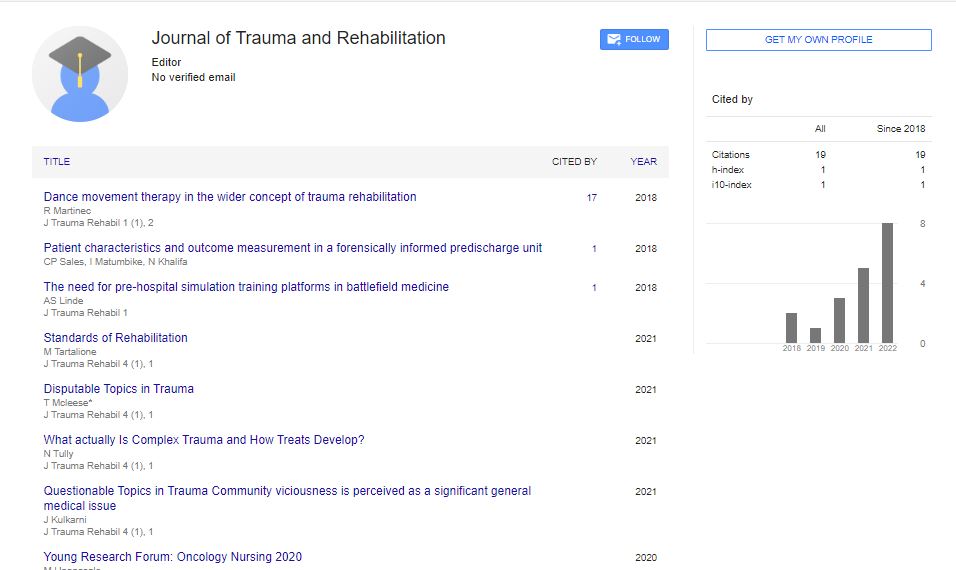Short Communication, J Trauma Rehabil Vol: 6 Issue: 1
Advanced Rehabilitation Techniques: Innovations in Improving Patient Outcomes
Wasay Nizam*
Department of Otolaryngology, University of Colorado School of Medicine, Aurora, United States of America
*Corresponding Author: Wasay Nizam
Department of Otolaryngology, University of Colorado School of Medicine, Aurora, United States of America
E-mail: nizam39@gmail.com
Received date: 18 February, 2023, Manuscript No. JTR-23-97127;
Editor assigned date: 20 February, 2023, PreQC No. JTR-23-97127 (PQ);
Reviewed date: 06 March, 2023, QC No. JTR-23-97127;
Revised date: 13 March, 2023, Manuscript No. JTR-23-97127 (R);
Published date: 20 March, 2023, DOI: 10.4172/Jtr.1000121
Citation: Nizam W (2023) Advanced Rehabilitation Techniques: Innovations in Improving Patient Outcomes. J Trauma Rehabil 6:1.
Description
Rehabilitation is an essential aspect of healthcare that aims to help patients recover from injuries, illnesses, or disabilities that affect their daily lives. Over the years, advances in rehabilitation techniques have enabled patients to recover faster, improve their physical function, and enhance their quality of life [1,2].
Advanced rehabilitation techniques encompass a range of innovative strategies that are designed to improve patient outcomes. These techniques are based on cutting-edge technologies, research, and clinical practices and they are tailored to meet the unique needs of individual patients. In this article, we will explore some of the advanced rehabilitation techniques that are transforming the field of healthcare [3].
Virtual Reality (VR) therapy is a form of rehabilitation that uses computer-generated environments to simulate real-life situations [4]. This technique is particularly useful for patients with neurological conditions, such as stroke or traumatic brain injury, as it can help them relearn skills and regain their independence. For example, a patient with a motor deficit can use VR to practice daily tasks, such as getting dressed or preparing a meal, in a safe and controlled environment [5].
Robotic rehabilitation involves the use of robotic devices to assist patients with movement, balance, and coordination. These devices are programmed to provide targeted support and resistance to specific muscle groups, allowing patients to perform exercises with greater precision and accuracy. Robotic rehabilitation is particularly effective for patients with spinal cord injuries, as it can help them regain strength and mobility in their upper and lower extremities [6,7].
Brain-Computer Interfaces (BCIs) are devices that allow individuals to control computers or other devices using their brainwaves [8]. BCIs can be used to help patients with paralysis or other disabilities, enabling them to perform everyday tasks, such as typing or controlling a wheelchair, with their thoughts. BCIs can also be used to help patients with neurological conditions, such as epilepsy or depression, by providing real-time feedback on brain activity and enabling targeted stimulation [9].
Constraint-Induced Movement Therapy (CIMT) is a rehabilitation technique that involves restraining the unaffected limb and forcing the patient to use the affected limb for everyday tasks. This technique is particularly useful for patients with stroke or other neurological conditions, as it can help them regain strength and function in their affected limb. CIMT can also help patients overcome learned non-use, a phenomenon where the patient avoids using their affected limb due to a lack of confidence or fear of pain [10].
Tele-rehabilitation involves the use of telecommunication technologies to deliver rehabilitation services remotely. This technique is particularly useful for patients who live in remote areas or have limited mobility, as it enables them to receive rehabilitation services from the comfort of their own home. Tele-rehabilitation can also be used to provide ongoing support to patients after they have completed their in-person rehabilitation program, helping them maintain their progress and prevent relapse.
Conclusion
Advanced rehabilitation techniques are transforming the field of healthcare by providing innovative strategies to improve patient outcomes. From virtual reality therapy to tele-rehabilitation, these techniques are helping patients recover faster, improve their physical function, and enhance their quality of life. As research and technology continue to evolve, we can expect to see even more innovative rehabilitation techniques in the future.
References
- Chou CH, Hwang CL, Wu YT (1012) Effect of exercise on physical function, daily living activities, and quality of life in the frail older adults: a meta-analysis. Arch Phys Med Rehabil 93: 237-244.
[Crossref][GoogleScholar][Pubmed] - Beaton DE, Schemitsch E (2003) Measures of health-related quality of life and physical function. Clin Orthop Relat Res 413: 90-105.
[Crossref][GoogleScholar][Pubmed] - Gomes MA, Kovaleski JL, Pagani RN, Silva VL, Pasquini TC (2023) Transforming healthcare with big data analytics: Technologies, techniques and prospects. J Med Eng Technol 47: 1-1.
[Crossref][GoogleScholar][Pubmed] - Parsons TD, Rizzo AA, Rogers S, York P (2009) Virtual reality in paediatric rehabilitation: a review. Dev Neurorehabil 12: 224-238.
[Crossref][GoogleScholar][Pubmed] - Crosbie JH, Lennon S, Basford JR, Donough SM (2007) Virtual reality in stroke rehabilitation: still more virtual than real. Disabil Rehabil 29: 1139-1146. [Crossref][GoogleScholar][Pubmed]
- Laut J, Porfiri M, Raghavan P (2016) The present and future of robotic technology in rehabilitation. Curr Phys Med Rehabil Rep 4: 312-319.
[Crossref][GoogleScholar][Pubmed] - Napper SA, Seaman RL (1989) Applications of robots in rehabilitation. Rob Auton Syst 5: 227-239.
[Crossref][GoogleScholar] - Moore MM (2003) Real-world applications for brain-computer interface technology. IEEE Trans Neural Syst Rehabil Eng 11: 162-165.
[Crossref][GoogleScholar][Pubmed] - Smalley E (2019) The business of brain-computer interfaces. Nat Biotechnol 37: 978-982.
[Crossref][GoogleScholar][Pubmed] - Corbetta D, Sirtori V, Moja L, Gatti R (2010) Constraint-induced movement therapy in stroke patients: systematic review and meta-analysis. Eur J Phys Rehabil Med 46: 537-544.
[GoogleScholar][Pubmed]
 Spanish
Spanish  Chinese
Chinese  Russian
Russian  German
German  French
French  Japanese
Japanese  Portuguese
Portuguese  Hindi
Hindi 